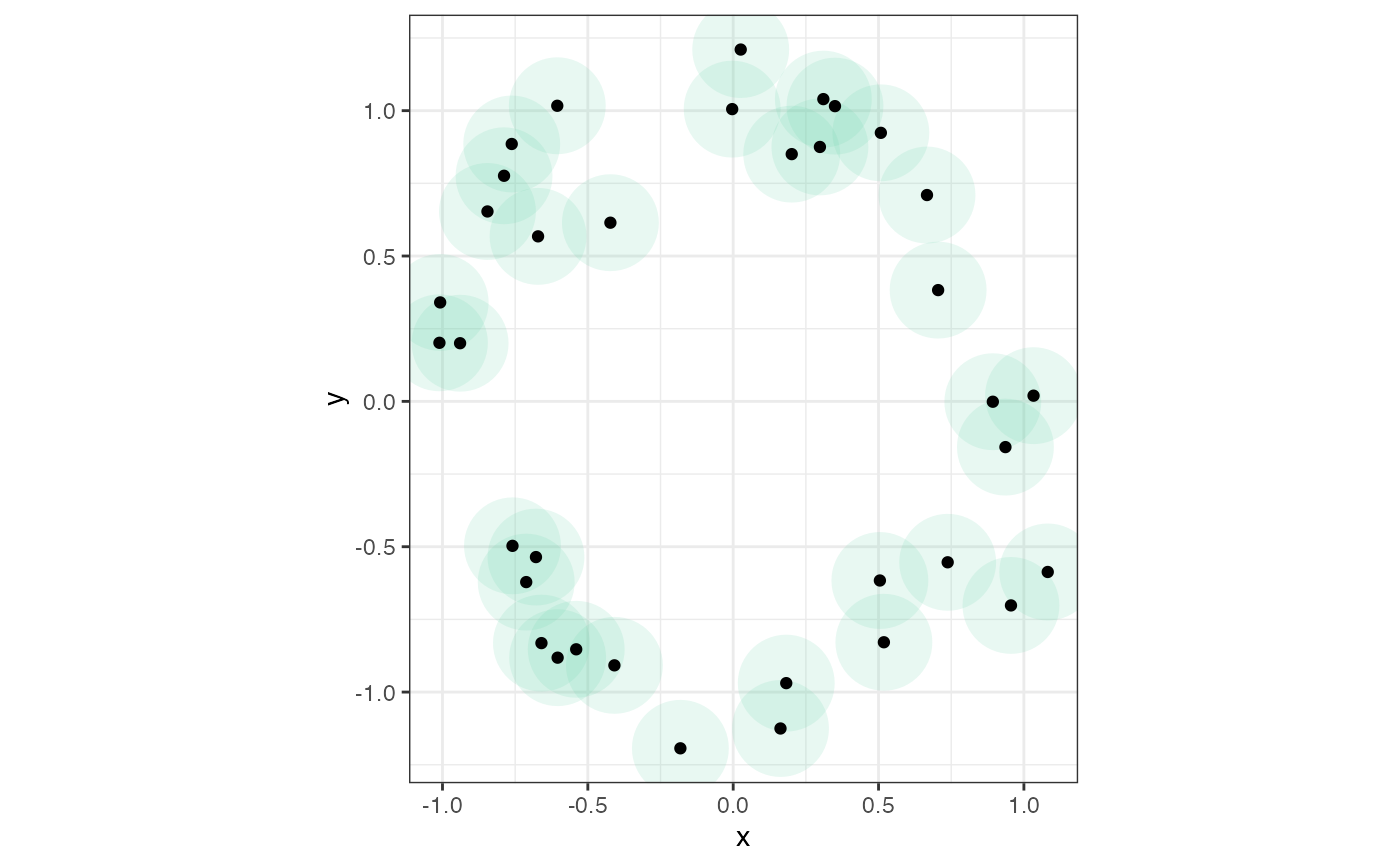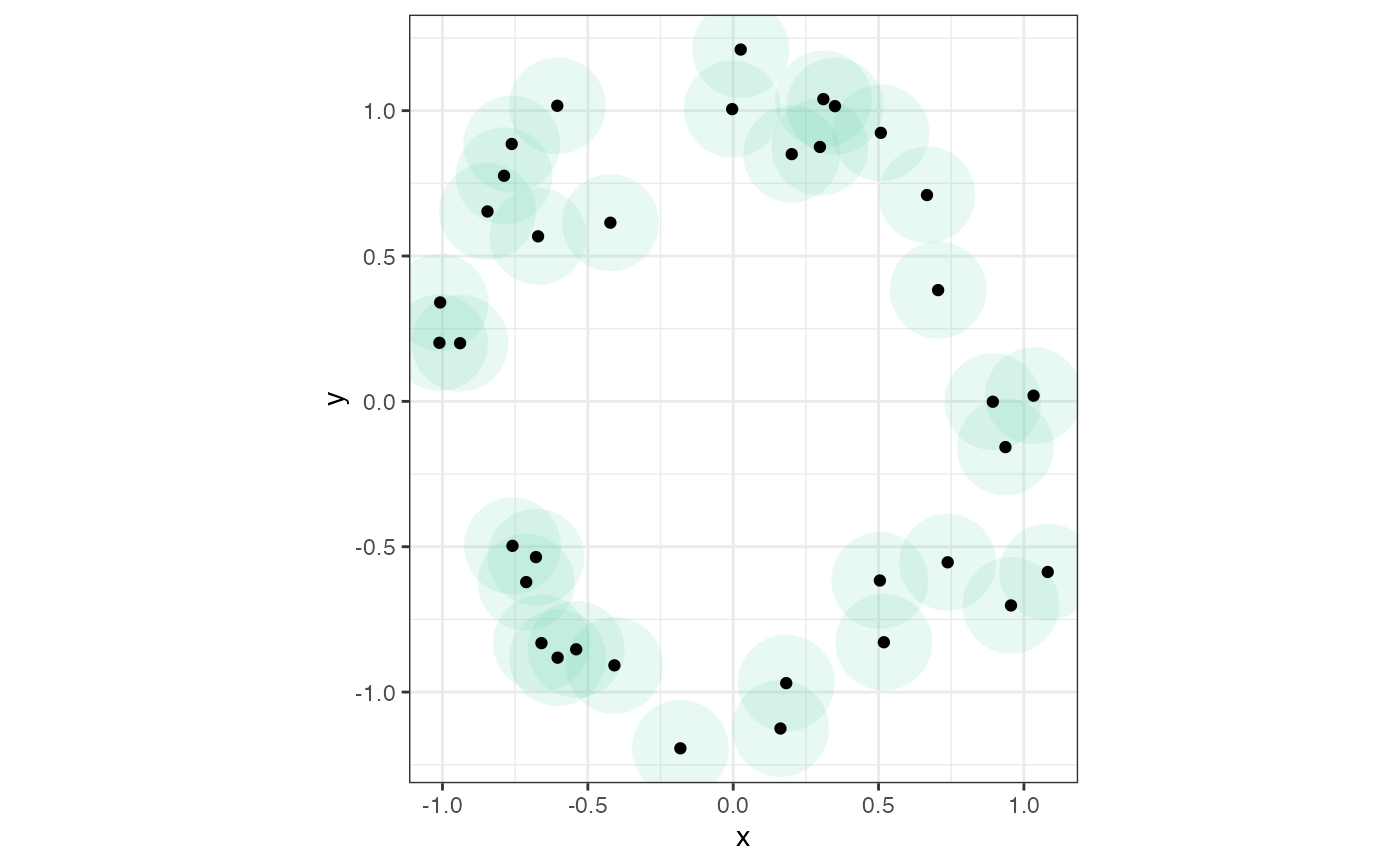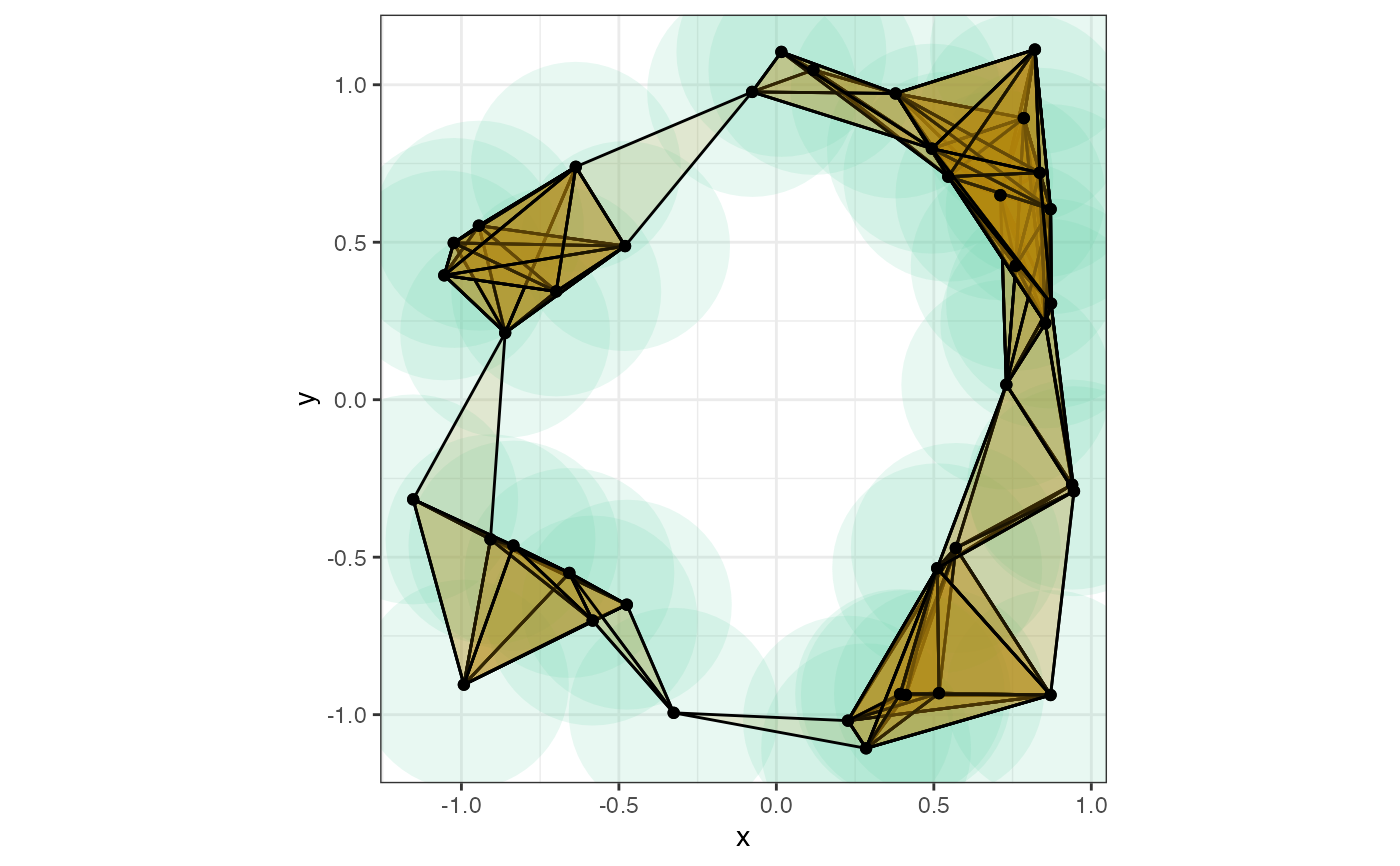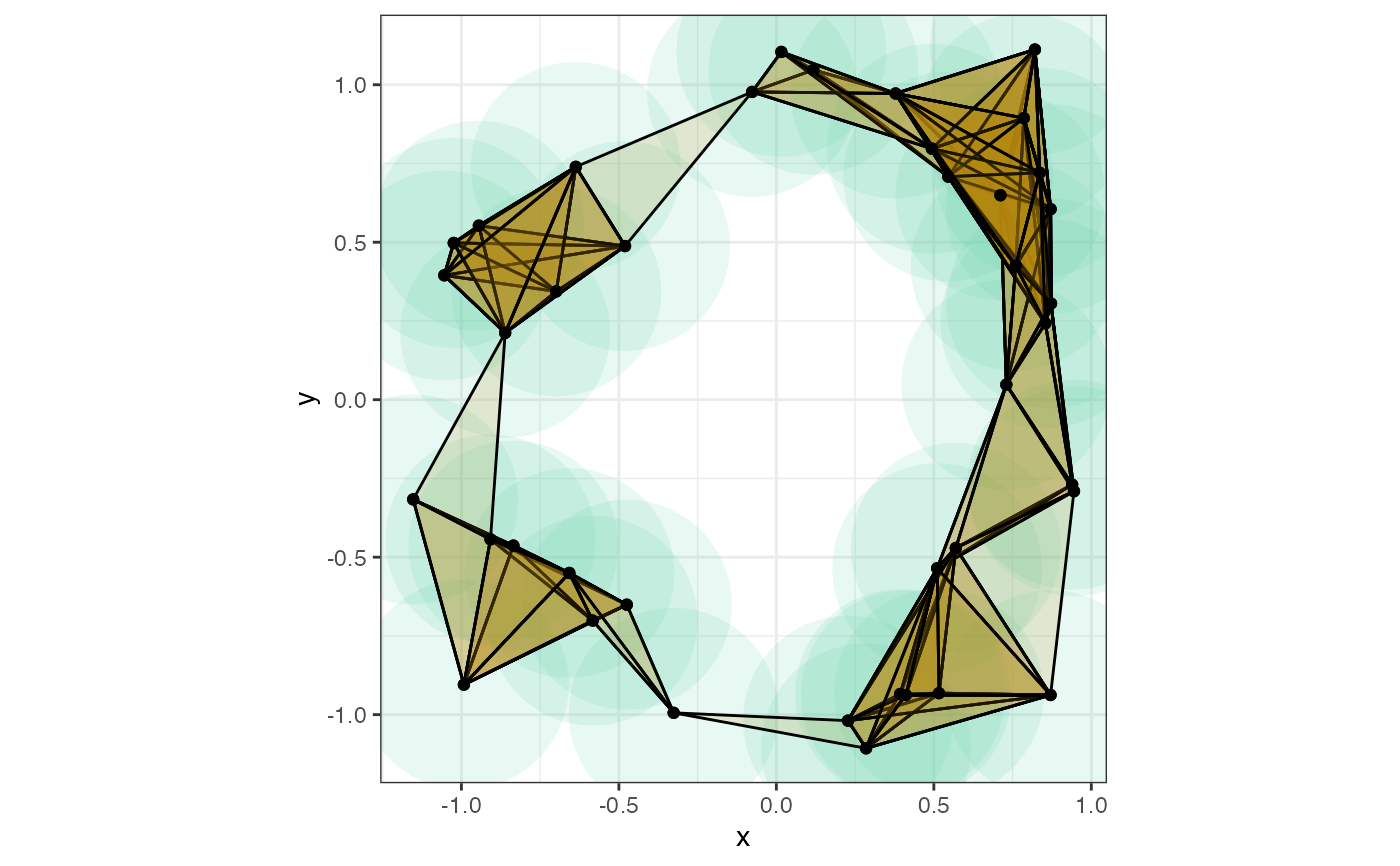Center disks at points in a scatterplot.
geom_disk(
mapping = NULL,
data = NULL,
stat = "identity",
position = "identity",
na.rm = FALSE,
radius = NULL,
diameter = NULL,
segments = 60L,
show.legend = NA,
inherit.aes = TRUE,
...
)Arguments
- mapping
Set of aesthetic mappings created by
aes(). If specified andinherit.aes = TRUE(the default), it is combined with the default mapping at the top level of the plot. You must supplymappingif there is no plot mapping.- data
The data to be displayed in this layer. There are three options:
If
NULL, the default, the data is inherited from the plot data as specified in the call toggplot().A
data.frame, or other object, will override the plot data. All objects will be fortified to produce a data frame. Seefortify()for which variables will be created.A
functionwill be called with a single argument, the plot data. The return value must be adata.frame, and will be used as the layer data. Afunctioncan be created from aformula(e.g.~ head(.x, 10)).- stat
The statistical transformation to use on the data for this layer, either as a
ggprotoGeomsubclass or as a string naming the stat stripped of thestat_prefix (e.g."count"rather than"stat_count")- position
Position adjustment, either as a string naming the adjustment (e.g.
"jitter"to useposition_jitter), or the result of a call to a position adjustment function. Use the latter if you need to change the settings of the adjustment.- na.rm
Logical; ignored.
- radius, diameter
The (positive) radius or diameter used in the construction. Provide only one of these; if neither is provided, they default to zero.
- segments
The number of segments in the regular polygon that approximates each disk
- show.legend
logical. Should this layer be included in the legends?
NA, the default, includes if any aesthetics are mapped.FALSEnever includes, andTRUEalways includes. It can also be a named logical vector to finely select the aesthetics to display.- inherit.aes
If
FALSE, overrides the default aesthetics, rather than combining with them. This is most useful for helper functions that define both data and aesthetics and shouldn't inherit behaviour from the default plot specification, e.g.borders().- ...
Additional arguments passed to
ggplot2::layer().
Details
A ball of radius \(r\) around a point \(x\) in Euclidean space consists of all points whose distances from \(x\) are less than \(r\). A ball in 2 dimensions is called a disk.
The geometric objects of GeomDisk can be used to illustrate disk covers of
point clouds, in particular in the construction of simplicial filtrations. It
could be paired with a statistical transformation of Stat* that samples
points from a cloud.
The convenience function geom_disk() produces a layer with the identity
statistical transformation.
Aesthetics
geom_disk() understands the following aesthetics (required aesthetics are in bold):
xyalphacolourfillgrouplinetypelinewidth
Learn more about setting these aesthetics in vignette("ggplot2-specs", package = "ggplot2").
See also
ggplot2::layer() for additional arguments.
Other plot layers for point clouds:
simplicial_complex
Examples
# function to generate noisy 2D circles
make_noisy_circle <- function(n, sd = .01) {
theta <- stats::runif(n = n, min = 0, max = 2*pi)
cbind(x = cos(theta) + stats::rnorm(n, 0, sd),
y = sin(theta) + stats::rnorm(n, 0, sd))
}
# generate a noisy 2D circle
set.seed(1)
d <- as.data.frame(make_noisy_circle(n = 36L, sd = .15))
r <- 1/6
# plot disks beneath points
ggplot(d, aes(x = x, y = y)) +
theme_bw() +
coord_fixed() +
geom_disk(radius = r, fill = "aquamarine3") +
geom_point()
 # use `diameter` parameter
ggplot(d, aes(x = x, y = y)) +
theme_bw() +
coord_fixed() +
geom_disk(diameter = 2*r, fill = "aquamarine3") +
geom_point()
# use `diameter` parameter
ggplot(d, aes(x = x, y = y)) +
theme_bw() +
coord_fixed() +
geom_disk(diameter = 2*r, fill = "aquamarine3") +
geom_point()
 # generate a noisy 2D circle
set.seed(2)
theta <- stats::runif(n = 40L, min = 0, max = 2*pi)
d <- data.frame(x = cos(theta) + stats::rnorm(40L, 0, .15),
y = sin(theta) + stats::rnorm(40L, 0, .15))
r <- 1/3
# overlay ball cover and Vietoris-Rips complex with points
ggplot(d, aes(x = x, y = y)) +
theme_bw() +
coord_fixed() +
geom_disk(radius = r, fill = "aquamarine3") +
geom_simplicial_complex(
radius = r, fill = "darkgoldenrod",
complex = "Vietoris", engine = "base"
) +
geom_point()
# generate a noisy 2D circle
set.seed(2)
theta <- stats::runif(n = 40L, min = 0, max = 2*pi)
d <- data.frame(x = cos(theta) + stats::rnorm(40L, 0, .15),
y = sin(theta) + stats::rnorm(40L, 0, .15))
r <- 1/3
# overlay ball cover and Vietoris-Rips complex with points
ggplot(d, aes(x = x, y = y)) +
theme_bw() +
coord_fixed() +
geom_disk(radius = r, fill = "aquamarine3") +
geom_simplicial_complex(
radius = r, fill = "darkgoldenrod",
complex = "Vietoris", engine = "base"
) +
geom_point()
 # use the Čech complex instead
ggplot(d, aes(x = x, y = y)) +
theme_bw() +
coord_fixed() +
geom_disk(radius = r, fill = "aquamarine3") +
geom_simplicial_complex(
radius = r, fill = "darkgoldenrod",
complex = "Cech", engine = "base"
) +
geom_point()
# use the Čech complex instead
ggplot(d, aes(x = x, y = y)) +
theme_bw() +
coord_fixed() +
geom_disk(radius = r, fill = "aquamarine3") +
geom_simplicial_complex(
radius = r, fill = "darkgoldenrod",
complex = "Cech", engine = "base"
) +
geom_point()
